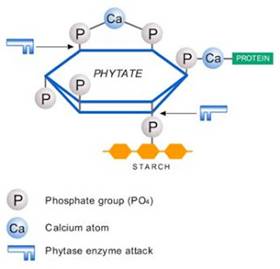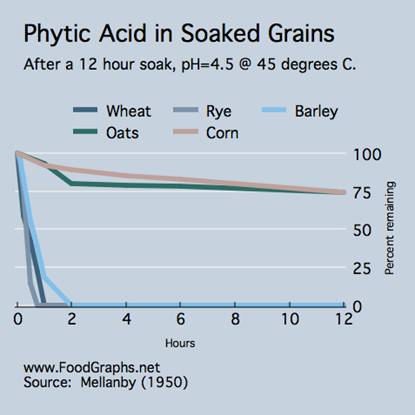Phytase is any type of phosphatase enzyme that breaks down phytic acid (a chemical process called dephosphorylation, produces a phosphate ion and a molecule with a free hydroxyl group) - phytase catalyzes the hydrolysis (requires water) of phytic acid by removing a phosphate group from its substrate to release a usable form of inorganic phosphorus. Phytase activity is measured in FTU (a worldwide standard).
The break down of phytic acid by phytases results in two specific beneficial effects -both of which increase mineral availability and absorption (esp. bone-beneficial phosphorus)
(1) Allows the utilization/absorption of bound/stored nutrients in phytate -phytase can hydrolyze phytic acid, releasing phosphorus and other nutrients bound by phytic acid (E.g. minerals, protein and starch );

The binding is possible within a phosphate group or between two phosphate groups on either the same or different phytic acid molecules;
(2) Prevents phytic acid from binding to important minerals in the digestive tract -which would otherwise make them unavailable to the body.
Humans (and other non-ruminants) do produce phytase enzymes for breaking down phytic acid, but favorable gut bacteria do - interestingly, rat intestine had 30 times the phytase activity of the human intestine (ex-vivo) and therefore the results of rodent studies examining phytate degradation are unlikely to apply to humans.
In germ and bran of whole seed/grain, germination activates phytase - which breaks down phytic acid and releases phosphorus and other minerals needed by the developing plant embryo for new growth.
- Some grains contain more phytase than others
• High phytase grains - Wheat contains 14 times more phytase than rice; rye contains over twice as much as wheat (the reason rye is preferred as a starter for sourdough breads).
Egli I and others. The Influence of Soaking and Germination on the Phytase Activity and Phytic Acid Content of Grains and Seeds Potentially Useful for Complementary Feeding. Journal of Food Science 2002 Vol. 67, Nr. 9.
• Oatmeal has a low phytase content
Phytase activity depends on pH with the ideal pH being somewhere in the ~4.5 - 5.5 range -adding a mild acid to soaking water of phytate foods creates that "just right" pH environment for phytase action. Note that the stomach acid pH is much lower and not conducive to phytase activity.
- "pH was the most important factor in reducing the content of phytic acid during bread making, as phytic acid in doughs with pH 4.3-4.6 was more effectively reduced than in doughs with higher pH."
Phytase activity and degradation of phytic acid during rye bread making by Merete Møller Nielsen •Marianne Linde Damstrup •Agnete Dal Thomsen •Søren KjærsgËš rd Rasmussen •Ã…se Hansen Eur Food Res Technol 2007
- Reale et al concluded that lactic acid bacteria improved conditions for degrading phytic acid simply by lowering pH -they determined the ideal pH to be ~ 5.5
Reale A, Konietzny U, Coppola R, Sorrentino E, and Greiner R, 2007, 'The importance of lactic acid bacteria for phytate degradation during cereal dough fermentation', Journal of Agriculture and Food Chemistry, 55 (8), pp 2993-2997ACSPub
- Phytase activities are pH dependent with the highest activities being observed at a slightly acidic pH ( 5.1).
Food Reviews International Phytic Acid by Lori Oatway a; Thava Vasanthan b; James H. HelmField Crop Development Centre, Lacombe, Canada b Department of Agricultural Food and Nutritional Science, University of Alberta, Edmonton, Canada
- Bacterial flora in the colon produce phytase and also lactic acid that affects pH in favor of phytase activity -dephosphorylation of phytic acid releases calcium ions, which are absorbed from the colon
Sandström, B., Cederblad, A., Stenquist, B., & Andersson, H. (1990). Effect of inositol hexaphosphate on retention of zinc and calcium from the human colon. European Journal of Clinical Nutrition, 44, 705-708.

-A high phytate diet improves the ability of intestinal microbiota to degrade phytate (Markiewicz et al) - This is a big deal! - because it means that gut microbes "step up to the plate" and improve their efficiency at producing phytase enzymes to degrade phytate when there is a dietary increase in phytates. However, studies show that at best, still only about half of the intestinal dietary phytate is broken down. (Schlemmer et al 2009). This may be because phytate has both negative and positive roles to play in the body. Interestingly, of the various microbes examined, gram-positive anaerobes and lactic acid bacteria (i.e. the ones in sourdough) appeared to be the least effective in the hydrolysis of phytic acid, and E. Coli performed the best.
The message to take home here is:
(1) The importance of having a favorable, balanced gut flora.
(2) We probably don't need to go overboard with food preparation methods to reduce phytates unless our diet is "loaded" with them. If we moderate our phytate intake and consume animal fats containing natural vitamin A and vitamin D(mitigates effects of phytic acid), then healthy gut flora can probably deal with them on their own. What foods contain phytate?
Schlemmer, U., Frølich, W., Prieto, R.F. and Grases, F. (2009) Phytate in foods and significance for humans: food sources, intake, processing, bioavailability, protective role and analysis. Mol Nutr Food Res 53, S330-S375.
Phytase activity is increased within an ideal temperature range
Phytase is reduced /destroyed by:
- Steam heat -176 °F in 10 mins. or less
- Heat-processing -such as being in a wet solution at 131-149 °F
Peers FG. Phytase of Wheat. The Biochemical Journal 1953 53(1):102-110.
• EXTRUDED bran and whole grain cereals (E.g. All-bran ®, Bran Buds) are a recipe for digestive disaster and mineral deficiencies - Slurries of extremely high phytate grains are forced through tiny holes at high temperatures and pressures, which destroy the phytase enzymes that might have broken down some of the phytate - you might be regular, but at what cost? - flaxseed (negligible phytate content) and prunes are your better bet.
• Freezing and long storage times - fresh flour has more phytase than after being stored.
With WHOLE grains and legumes, cooking alone is NOT enough to activate phytase for a significant reduction of phytic acid -and cooking temperatures eventually destroy phytase altogether. To reduce phytic acid to a healthy level requires some preparation before cooking:
Campbell J and others. Nutritional Characteristics of Organic, Freshly stone-ground sourdough and conventional breads. http://eap.mcgill.ca/publications/EAP35.htm.